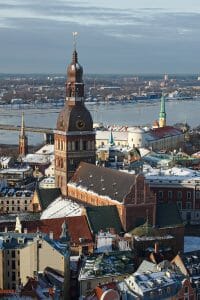
After our busy trip to Finland, we took a ferry back to Tallinn with the idea of continuing our trip in the Baltic countries a little bit slower. As we had already had a good taste of northern Estonia, we decided to take a bus directly to the city of Riga, the capital of Latvia. There would have been obviously other places to discover in Estonia… but since we can’t see everything anyway and we have to be back in Switzerland in mid-March, we might as well go in the right direction 😉 .
We will certainly come back to the subject of buses in the Baltic countries… But frankly, the quality/price ratio is quite impressive. In this case the trip between Tallinn and Riga takes between 4-5 hours and for about 15 euros (it’s even cheaper if you book in advance), we made the trip in a great bus with free wifi that worked like a charm. Imagine, I was able to stream the Australian Open final between Roger Federer and Marin Cilic… In short, buses in Eastern Europe are a different world if we compare them with Asia for example 😉
useful info
And if you want to take advantage of the trip to see more things on the way, an agency (which we tested and approved during this great daytrip to lahemaa) offers a Tallinn – Riga bus ride stopping at lots of places on the way. A nice concept that will allow you to see a lot of things on the way without wasting too much time.
Now let’s get on with a tour of Riga and the surrounding area!
- Latvia and Riga: a small historical context
- What to see, what to do in Riga: our favorites
- The old city of Riga, a UNESCO World Heritage Site
- The central market
- Āgenskalns market
- The bell tower of St-Peter’s church
- Art Nouveau in Riga
- Lastādija district
- The flea market of Latgale Tirgus
- Walk along the Daugava River
- Riga’s museums
- Bouldering in Riga – Program for a rainy day
- Rent a kayak to explore the city in a different way
- Going out in Riga: all the best places to eat, drink and have a coffee break
- Map of all the things to do in Riga
- Getting out and about in Riga: what to see around the capital?
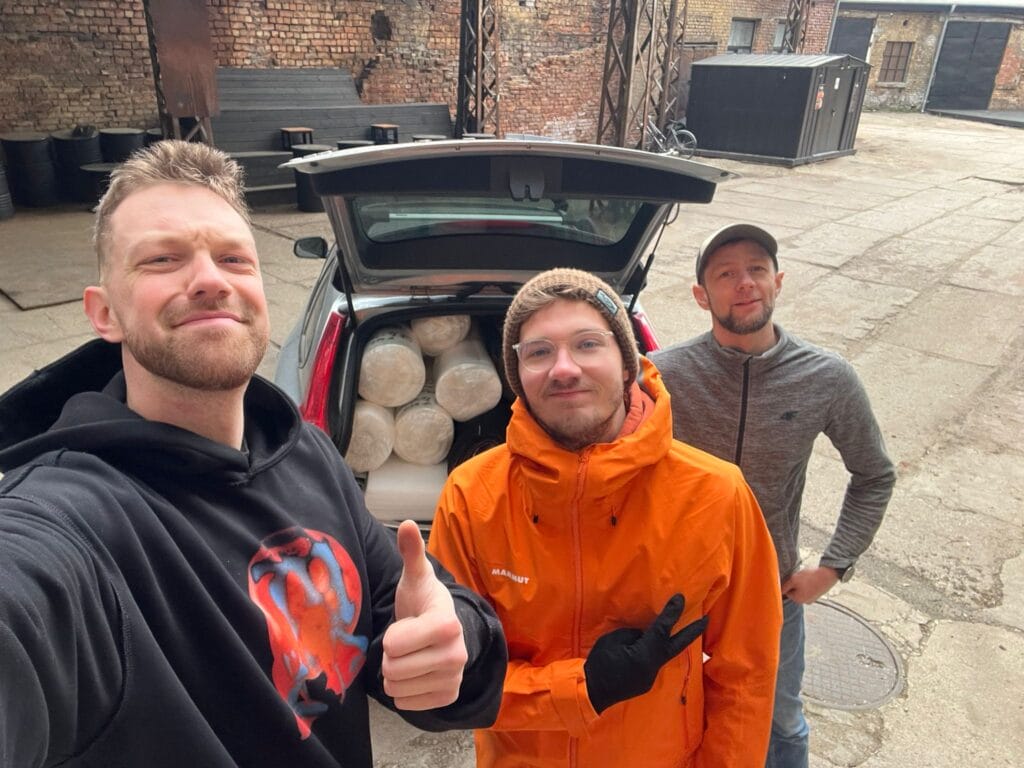
Big update 2024 :
we wrote this article in 2018 during our road trip in the Baltic States. In 2024, we proceeded to a very big update of the content notably thanks to our two friends Mārcis and Austris, two Latvians we met in our coliving and who know the city like the back of their hand! Opposite, a small photo of our 2 friends and in the background you can see Aleksis, who we’ll tell you more about below as he runs a pretty incredible bouldering gym in Riga! In short, get ready for lots of great tips and addresses 100% validated by locals!
Latvia and Riga: a small historical context
Until now, we hadn’ t told you much about the recent history in the Baltic States. However, it is impossible to travel to these countries without having some context, because the 20th century has been so difficult in this part of Europe. It is 2018 and everywhere in the Baltic countries we see posters / placards mentioning the 100 years of independence of these countries. This is because in Latvia (also in Estonia and Lithuania) independence was obtained at the end of the 1st World War allowing them to leave the Russian empire.
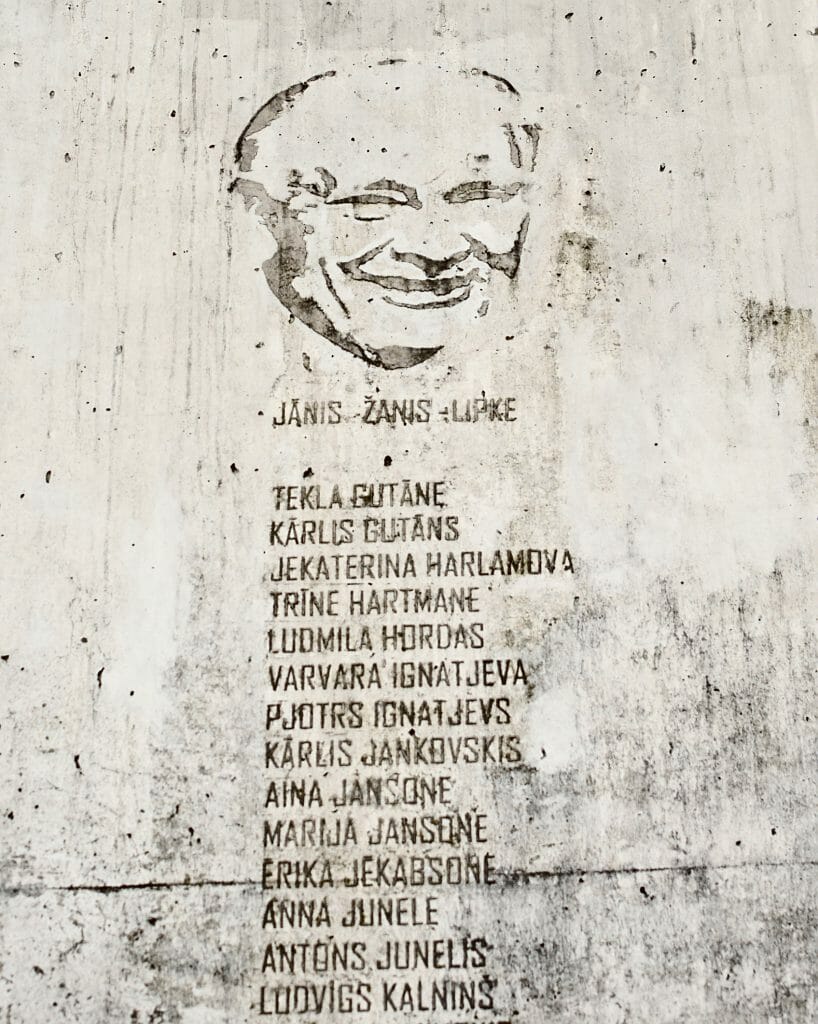
However, the peace was only short-lived as in 1939 Nazi Germany and the Soviet Union agreed to annex certain countries. Following this treaty, the Red Army invaded Latvia and the other Baltic countries with the firm intention of “sovietizing” these regions (meaning repressing and deporting the inhabitants). So much so that when Hitler’s Germany decided to attack Russia in 1941, they were almost welcomed as liberators by the Latvians. However, the Germans would not do better than the Russians until 1945 and the end of the Second World War.
Unfortunately for Latvia and the other Baltic countries, the Red Army regained control in 1945 and re-established Soviet power. This was followed by the difficult years of communism and Soviet occupation with all the horrors we know (the KGB, the gulags, Sovietization). This period, although particularly difficult until Stalin’s death in 1953, lasted until 1991 and the fall of the Soviet Union.
So it’s impossible to travel to Latvia and not have all this in mind because most of the people you meet on the street grew up in the Soviet Union. With this perspective, we must admit that we were really amazed by the incredible developments that these countries have experienced in such a short time…
it’s hard to imagine that about 30 years ago, they were still cut off from the rest of the world!
What to see, what to do in Riga: our favorites
So we stayed 9 days in Riga but we only visited the city and its surroundings 3-4 days because we also had a lot of work to do (we swear to you that we also work sometimes 🙂 ). But that still gave us time to make some nice discoveries that we are about to share with you in the rest of the article.
In Riga there are also free walking tours which are organized every day. Departure is at noon and the tour lasts about 2h-2h30 (visits are always in English). This is, in our opinion, an excellent way to start your tour of the city as it allows you to get a first glimpse of the city and also to be able to ask questions to a local guide.
The concept of the free tours is always the same: registration is free and at the end of the tour it is customary to leave a tip to the guide depending on how you found the tour.
The old city of Riga, a UNESCO World Heritage Site
Before the sad period described above, Riga was an important port city in Europe because of its strategic geographical location between east and west. It is therefore not surprising to find a very beautiful historical city centre that has been rather well preserved / restored given the events that took place in the 20th century. Frankly, it is really nice to stroll through the small streets of the old town with its pretty coloured facades. It is this mix between medieval buildings and Art Nouveau that has earned it a place on the UNESCO’s list of World Heritage Sites.
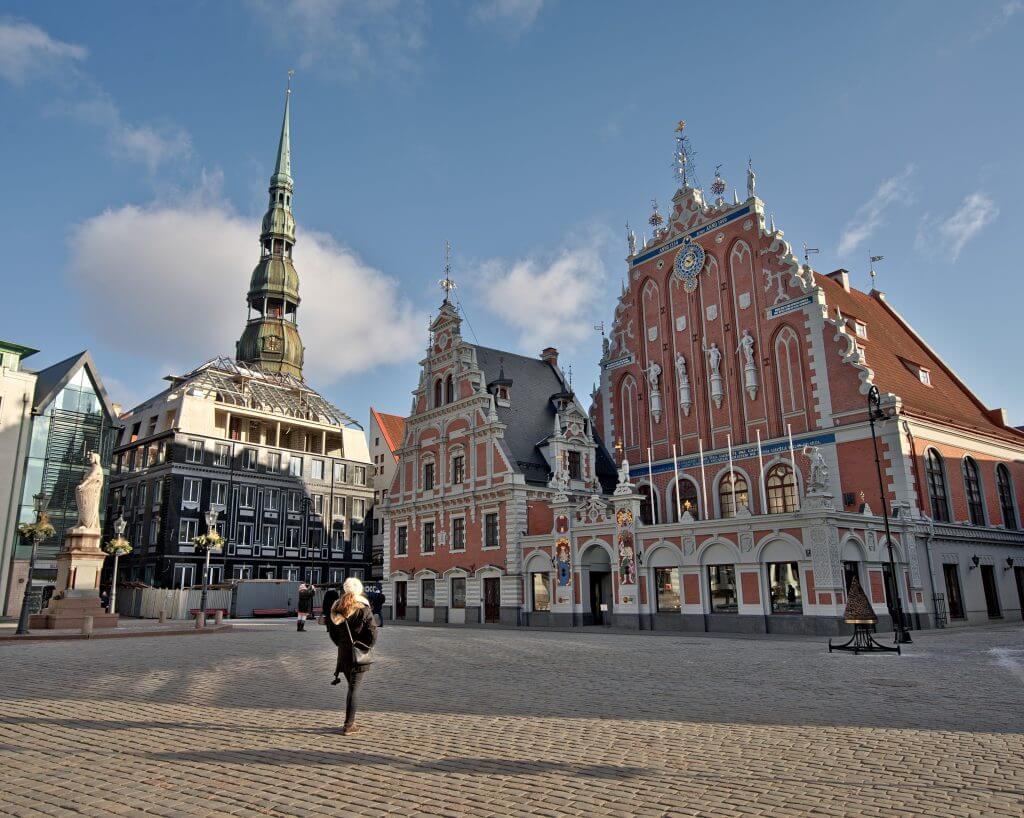
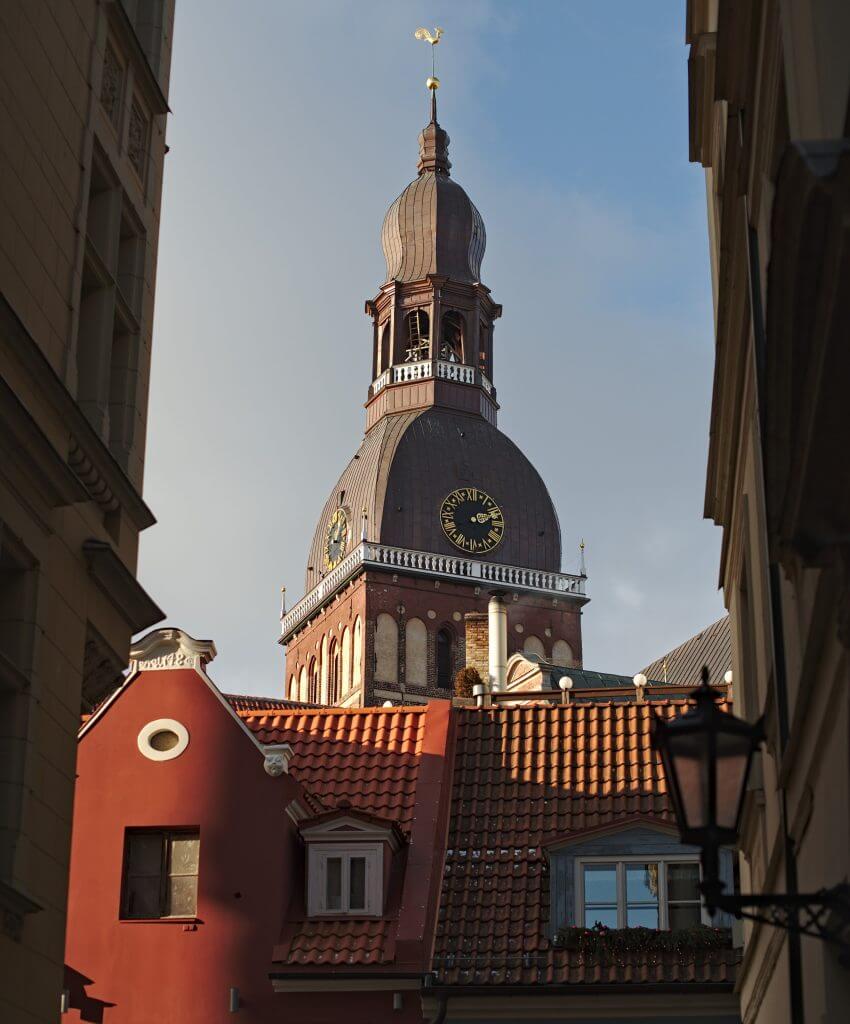
The central market
When we travel, we always love going to a local market with Fabienne. These are always very lively places that allow us to discover new flavours and see what people are buying in the country we are visiting. And on the market side we were spoiled in Riga since the central market is simply the largest covered market in Europe (when we told you that Riga was an important harbour).
After the 1st World War, the market was set up in a rather unusual place since it is still in old renovated Zepellin hangars. There are many fresh and local products that are really cheap. It is here that we discovered that Latvians love cabbage, pickles and potatoes 🙂 . You will be able to taste the different specialities without difficulty as you stroll through the market
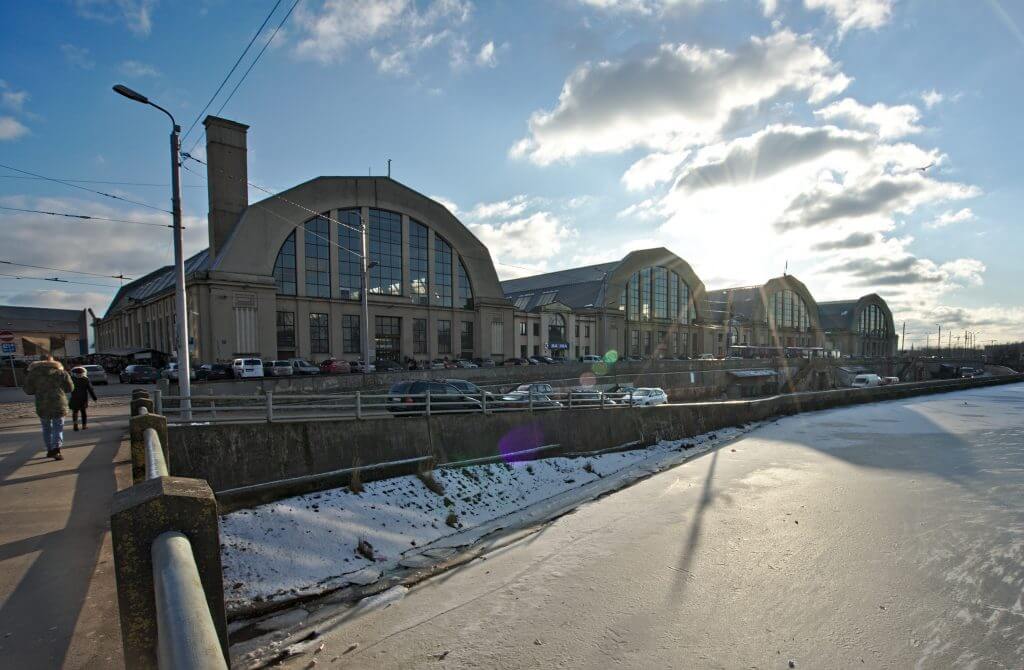
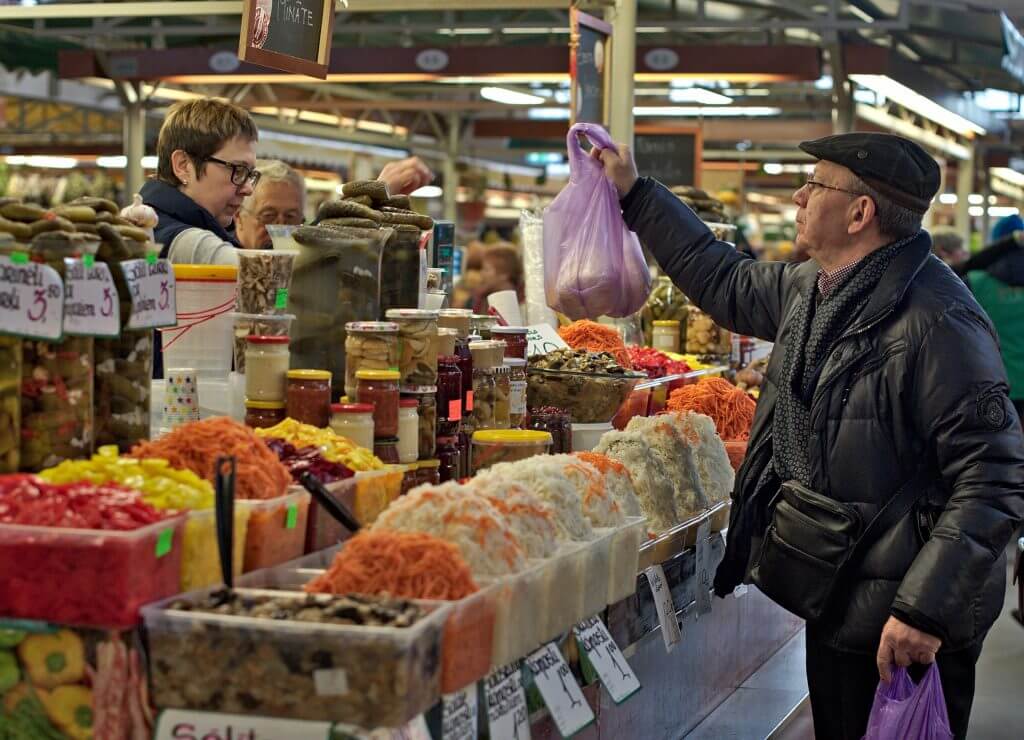
Āgenskalns market
This market is more recent (it didn’t yet exist when we visited Riga) but our friend tells us it’s become his favorite place! Of course, you’ll find fresh produce from local producers, but the Āgenskalns market is also a friendly place to come for a drink or something to eat in the many bars and cafés upstairs. Every Sunday, the place also hosts a large flea market, and on the ground floor of the building you’ll find second-hand stores, bulk stores, bookshops and more.
Find all the market events on their website (in english).
The bell tower of St-Peter’s church
Certainly the St-Peter’s church is pretty but its main interest lies in the fact that for the modest sum of 9€ / pers you can go up to the top of its bell tower to have a 360 degree view over the whole old town. So yes we agree, 9€ is expensive to climb into the bell tower of a church but if the weather is nice, we promise you that the view is worth it… check out the pics 😉
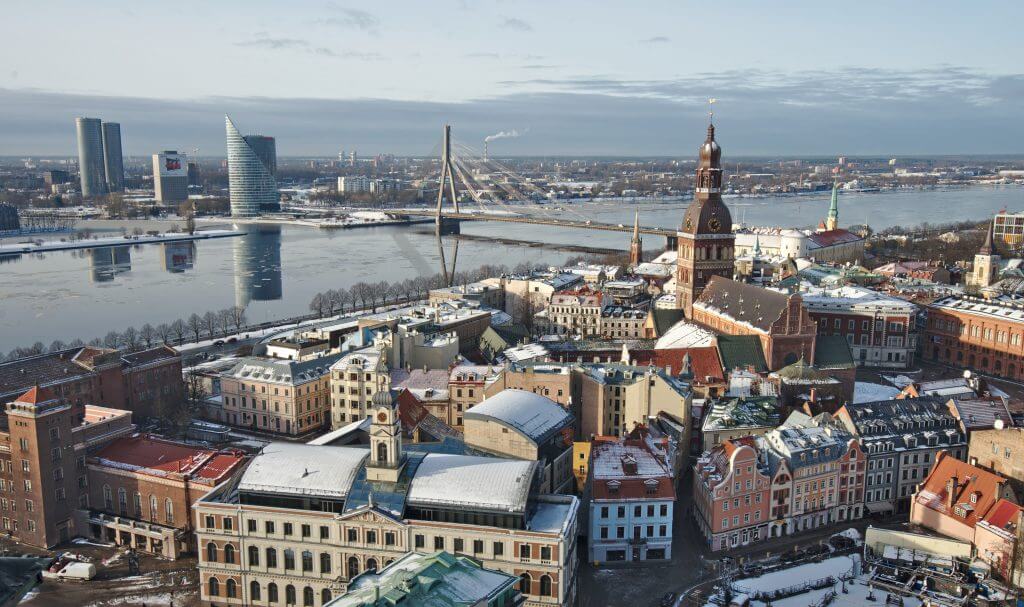
Art Nouveau in Riga
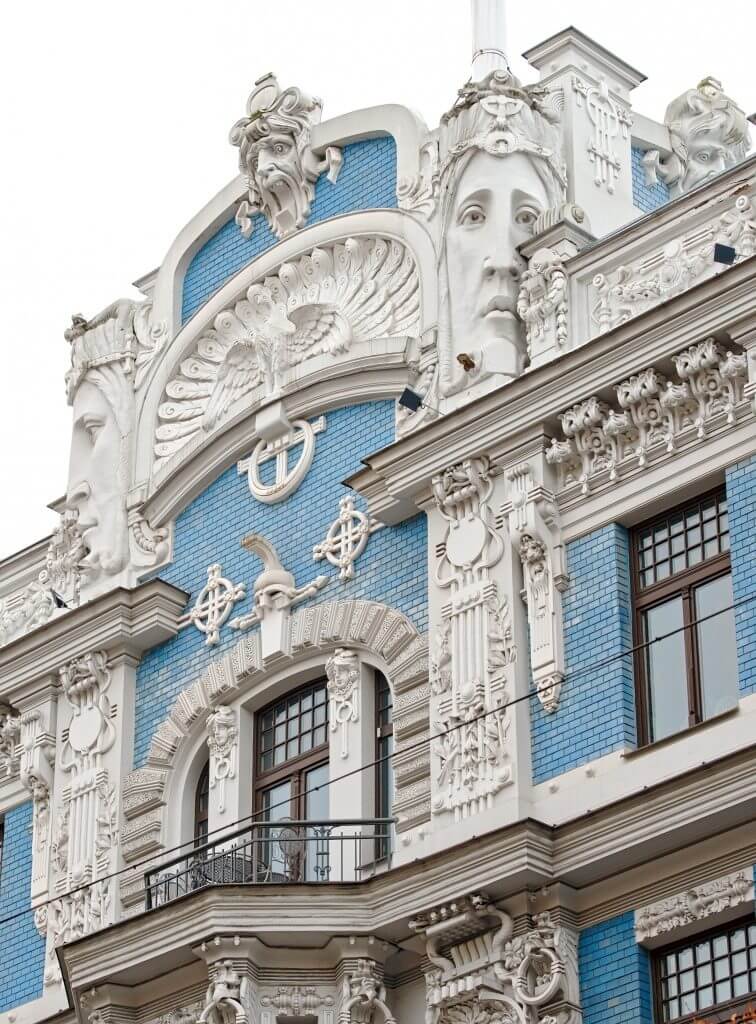
Before the First World War, Riga was an important city thanks to its strategic position and enjoyed rapid economic growth. It was at this time that most of the Art Nouveau style buildings were built in the city (there are still more than 800 of them left today). And it is still today the city that has the most important concentration of this style of construction in the world (which has earned it its place on the UNESCO World Heritage List).
So certainly we are not experts in architecture, but we liked all these buildings richly decorated and sculpted all around the old city (there are also some in the old city). To see the best restored examples of this style of architecture, we suggest you take a walk down Alberta Street, which is just beautiful.
Lastādija district
Another thing we like to do when visiting a city is a free walking tour (mentioned above). The concept is simple: a local guide takes you on a walking tour of the city, showing you his or her favorite spots. The tours are entirely tip-based, meaning that you leave whatever you like, depending on whether you liked the tour or not. So in Riga we took part in a slightly alternative tour that took us outside the old town to discover other places we wouldn’t necessarily have discovered on our own, and the Lastādija district was one of them.
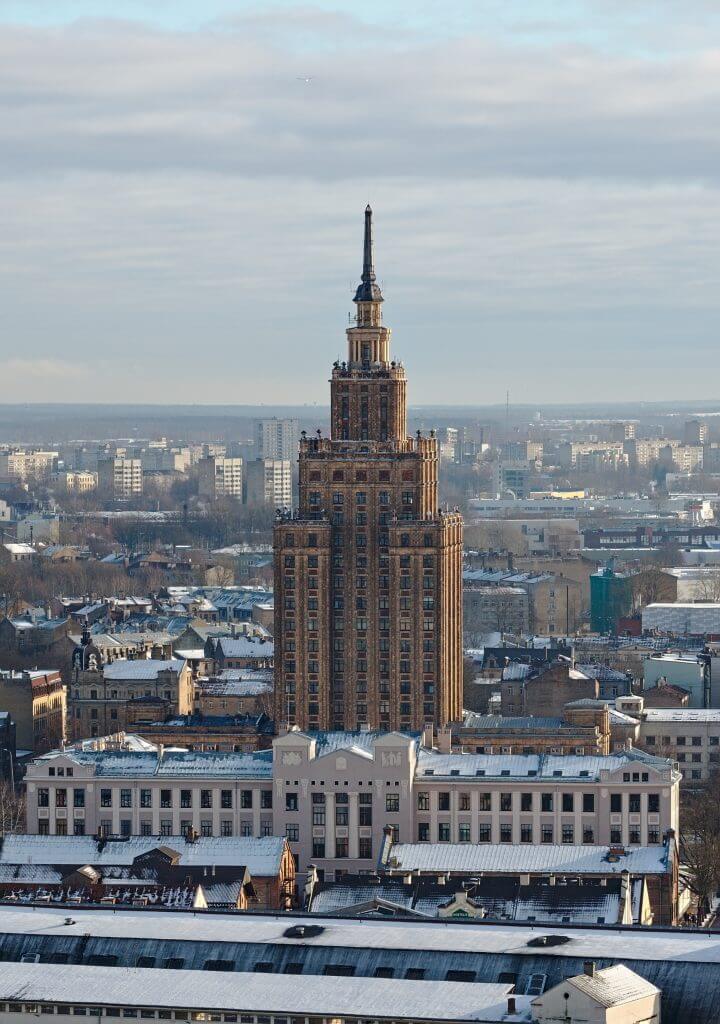
Located just beyond Central Market, this much more modest district is in stark contrast to the old town. Gone are the beautiful art-nouveau buildings, here the houses are mainly made of wood, as it was necessary to be able to burn them in the event of an enemy attack at the time. The district was formerly known as the “Moscow Quarter” but has since been renamed Lastādija. It is also infamous for having been used as a ghetto for Jews during the Nazi occupation of 1941-1945 (the ghetto museum is located here). At the end of the Soviet era, the place was rather a place to avoid for safety reasons and it was not really advised hanging around until about ten years ago. But nowadays, Riga has become a very safe city, and the new generation is trying to use some of the houses in this district for artistic and cultural projects. There’s also the impressive building of the Academy of Sciences (a large concrete block in pure Soviet style), which was built there in honor of Stalin. Speaking of the Academy of Sciences, our friend Marcis told us that it was well worth paying the 6€ to climb up to the observation platform, where the view is apparently magnificent!
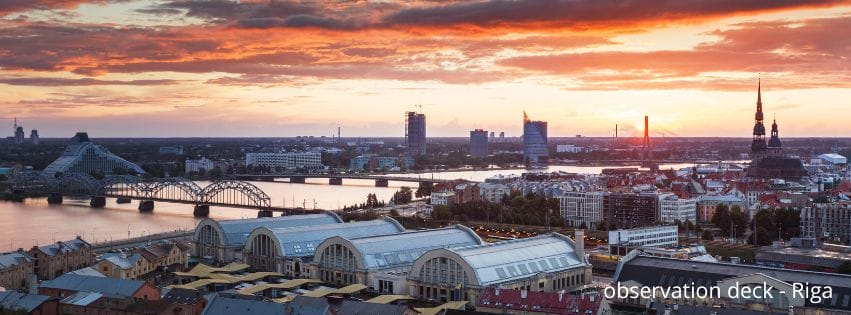
The flea market of Latgale Tirgus
This flea market is probably the place that left the most vivid memory of our trip to Riga. Also located in the Moscow district, I had the impression that I was teleported back 50 years when I entered it. It’s simple, you can find completely outdated electronics, old bike parts of all kinds, old cameras, lots of objects from the communist or Nazi period (uniform parts, buttons, weapons…) and many other old things. Even if you have no intention of buying anything, this place is worth a look just for the atmosphere. And if you like photography like me, this place is a little gem 😉 .
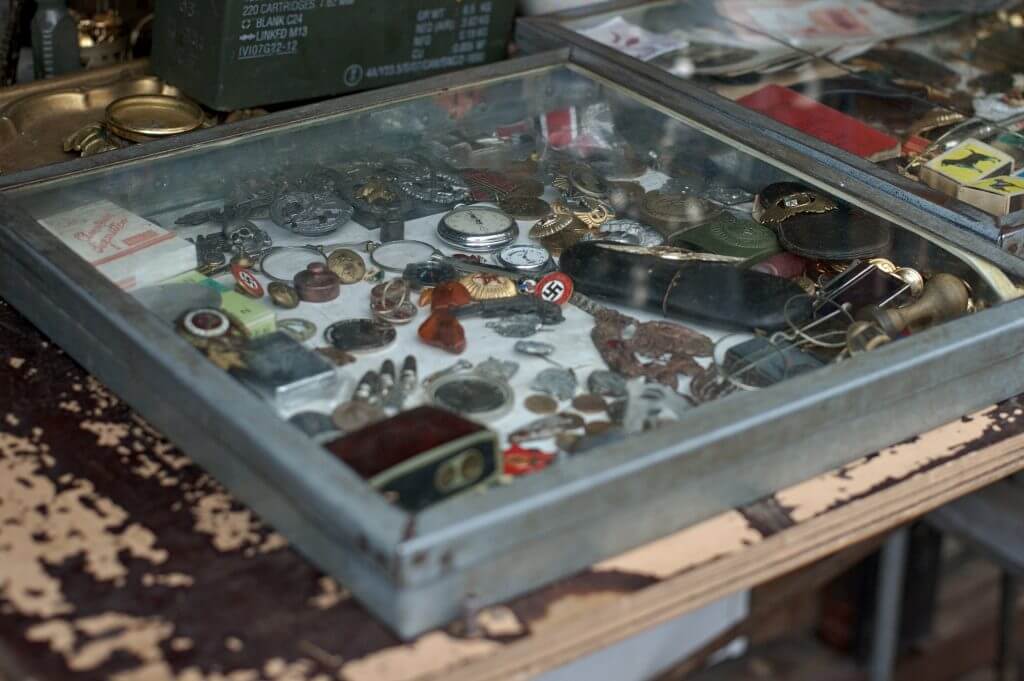
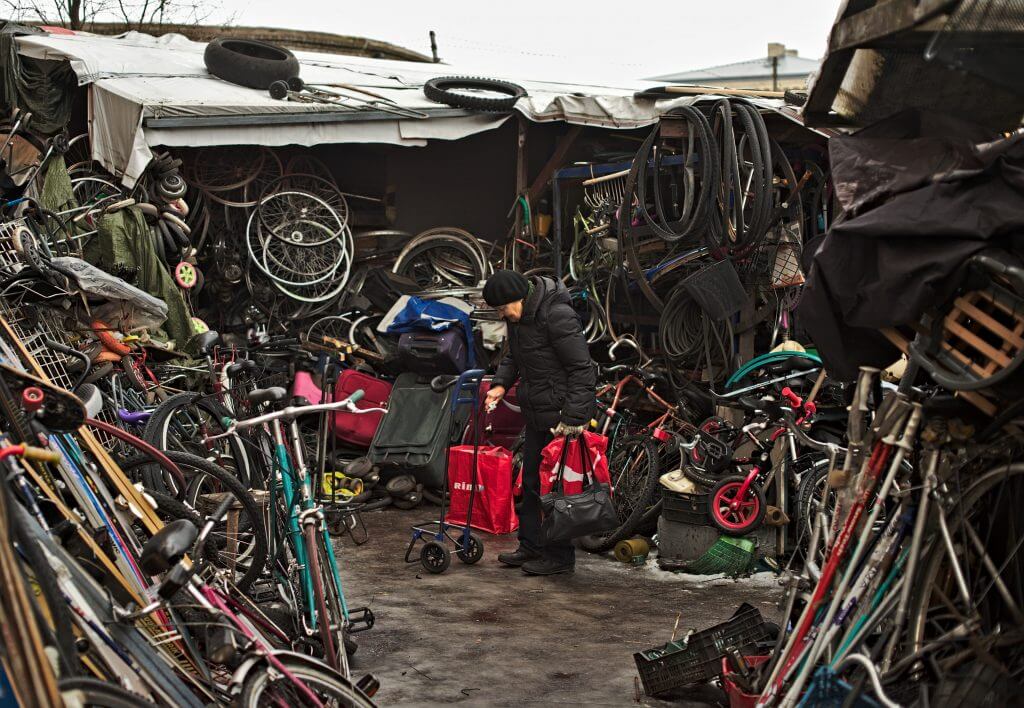
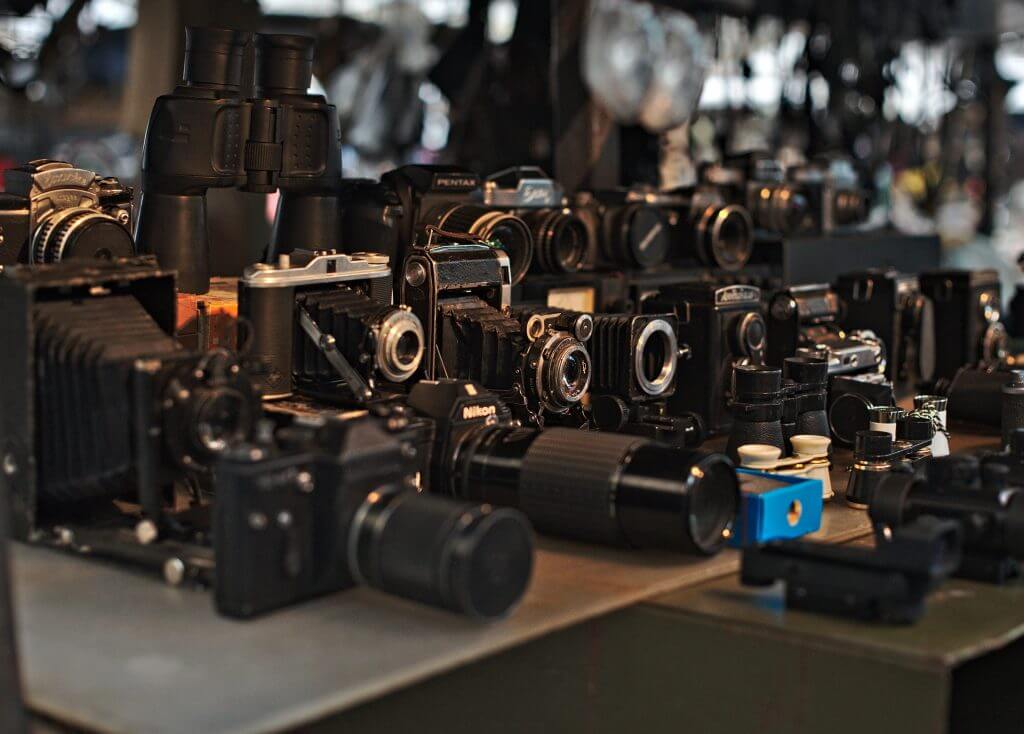
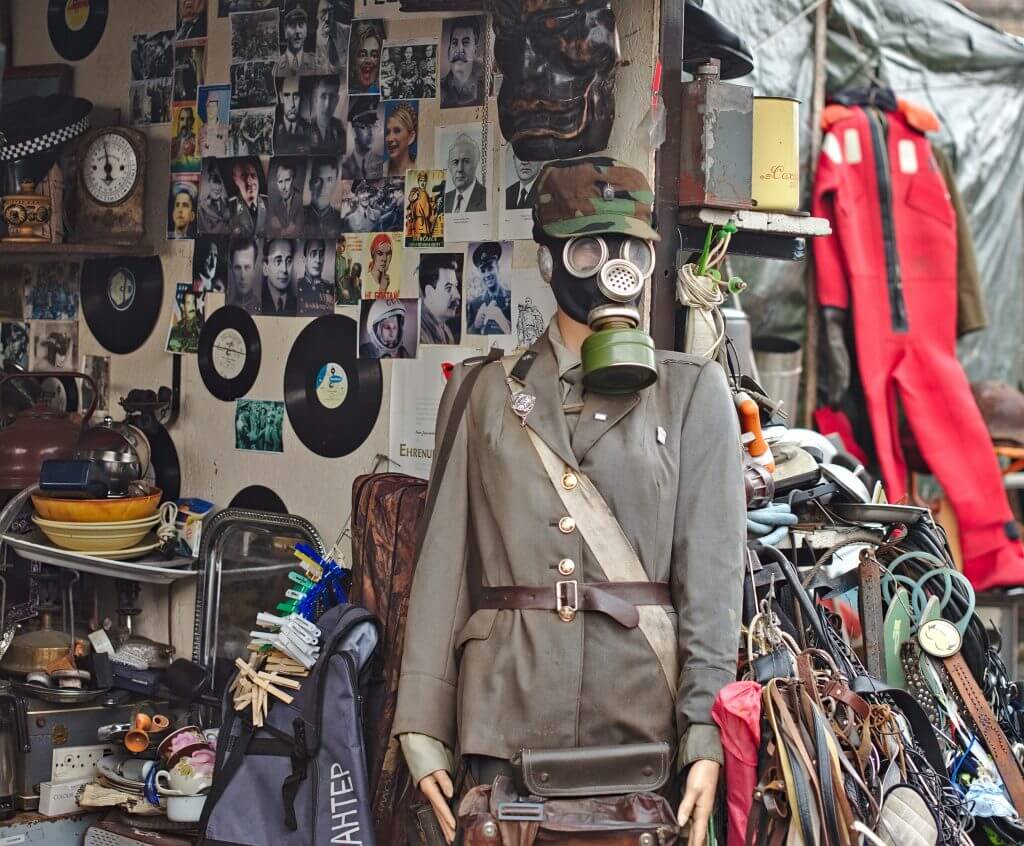
Walk along the Daugava River
During our 9 days in Riga, we had one unique sunset 🙂 (and if you wonder why there is blue sky in most of our photos, it’s because we took them all during the 4 hours of sunshine we had 😉 ). And if you want our opinion, one of the best places to enjoy the late afternoon is to go for a walk on the promenade along the Daugava River. In fact, if it had been a little warmer, we would have had a beer by the water.
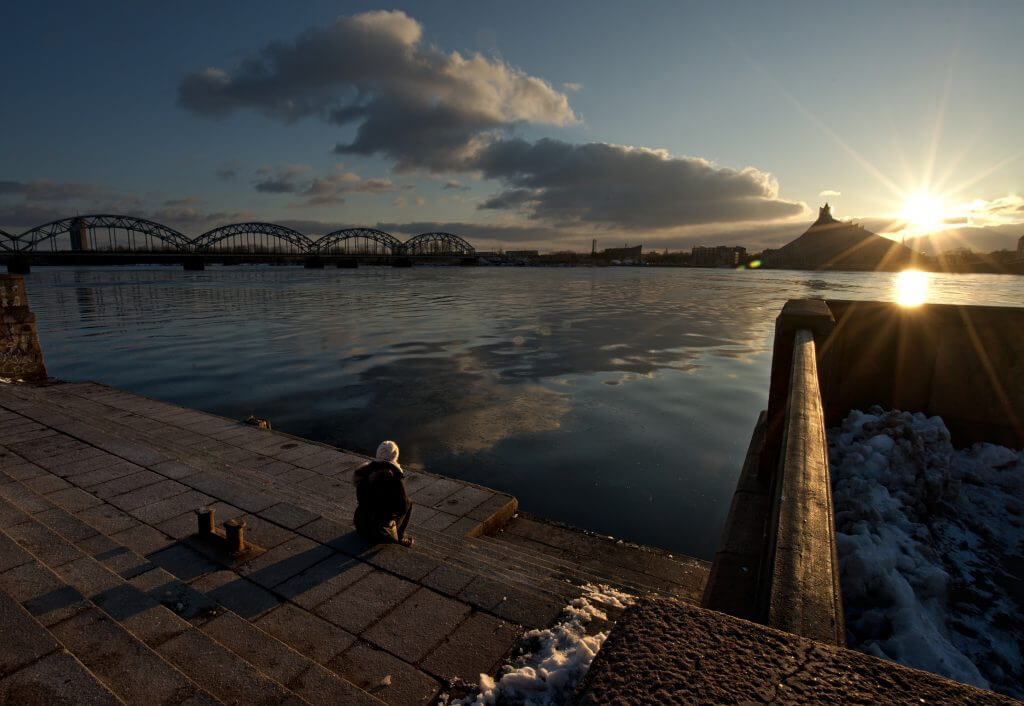
Riga’s museums
There are lots of museums in Riga and if, like us, you don’t necessarily have the best weather during your stay (we must have had 4 hours of sunshine over the 9 days 😉 ), ou may want to learn a little more than usual 🙂
- the Museum of Occupation: Although we visited the KGB Museum in Tallinn, we didn’t learned a lot about the topic of Soviet and Nazi occupation in the Baltic countries and we wanted to rectify it in Riga. The Occupation Museum is quite small but well organized and easy to follow. It gives an excellent overview of this dark period of occupation in Latvia (and the Baltic States in general) and it is also free. We really recommend a visit to this museum at the beginning of your stay to have this information in mind during your visits. More information about this museum here.
- Ghetto Museum: Located on the banks of the Daugava River in the Moscow district (which was also the former Jewish ghetto during World War II), this open-air museum traces the history of the ghetto during the occupation period. To be honest, we found the museum rather poorly organized and as it is outside, in winter we quickly froze. On the other hand, they have a very nice website.
- The house of Black Heads: this emblematic building can be visited and the entry only costs 6€. You can buy your tickets online here.
- There are quite a few other museums that we did not visit during our stay but if you are looking for others, we have heard a lot of good about the cars museum in Riga.
- If you’re a streeart enthusiast, you’ll find a list of the main murals on this website
See more ideas for things to do in Riga on Getyourguide
Bouldering in Riga – Program for a rainy day
To round off our list of things to see and do in Riga, we wanted to share with you an idea for an activity that may not be “classic”, but which might interest some of you 😉 This year, we decided to install a bouldering wall in our basement, and Aleksis, a friend of Austris, came all the way from Riga to help us design it. Aleksis runs his own bouldering gym in Riga (he built it all himself), so it’s only natural that we wanted to tell you about it. In fact, if you drop in to see him, don’t hesitate to say hello or send us a photo 😉
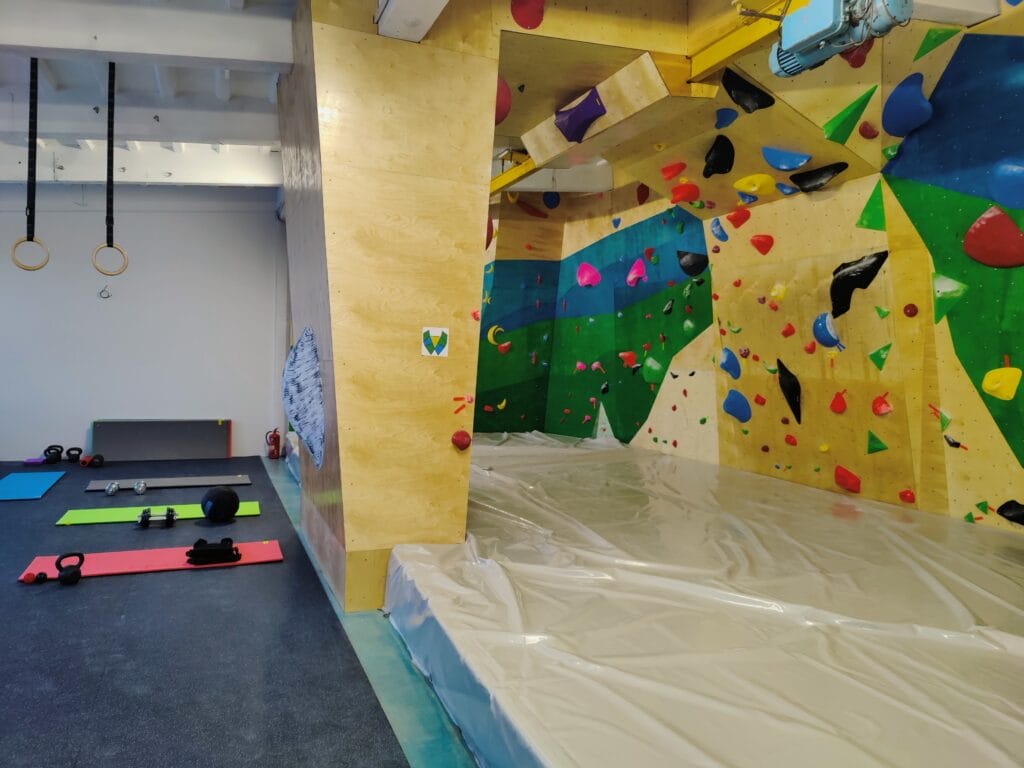
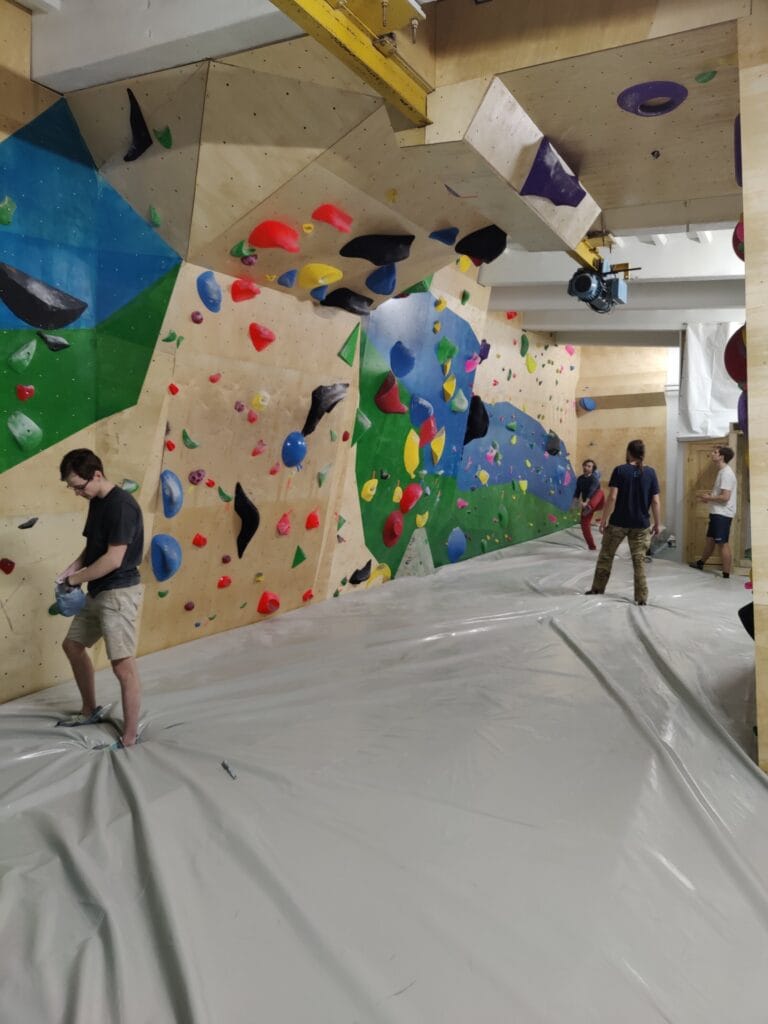
The bouldering gym is called Vagonuwall and is located in the exciting new district of the same name (Vagonu). Formerly a quite abandoned, the area is now booming with bars, concert halls and even a very good craft brewery, which happens to be right next door 😉 Admission to the block room costs 8.5€ and it’s open every day from 9am to 10pm. To see more pictures, you can follow them on their instagram. PS : The page is mainly in Latvian, but if you have any questions, you can call Aleksis (number at the bottom of the website). He speaks perfect English 😉
Rent a kayak to explore the city in a different way
If, unlike us, you’re in Riga during the summer months, an excellent plan is to explore the city by kayak (ok, it is technically also possible in winter, but somehow I feel this would be more enjoyable in summer or spring haha). Our friend Austris highly recommended this activity (friends of his run the rental company) and has personally tested almost all the routes. His favorite? The tour through the city center at sunrise or aperitif time 😉
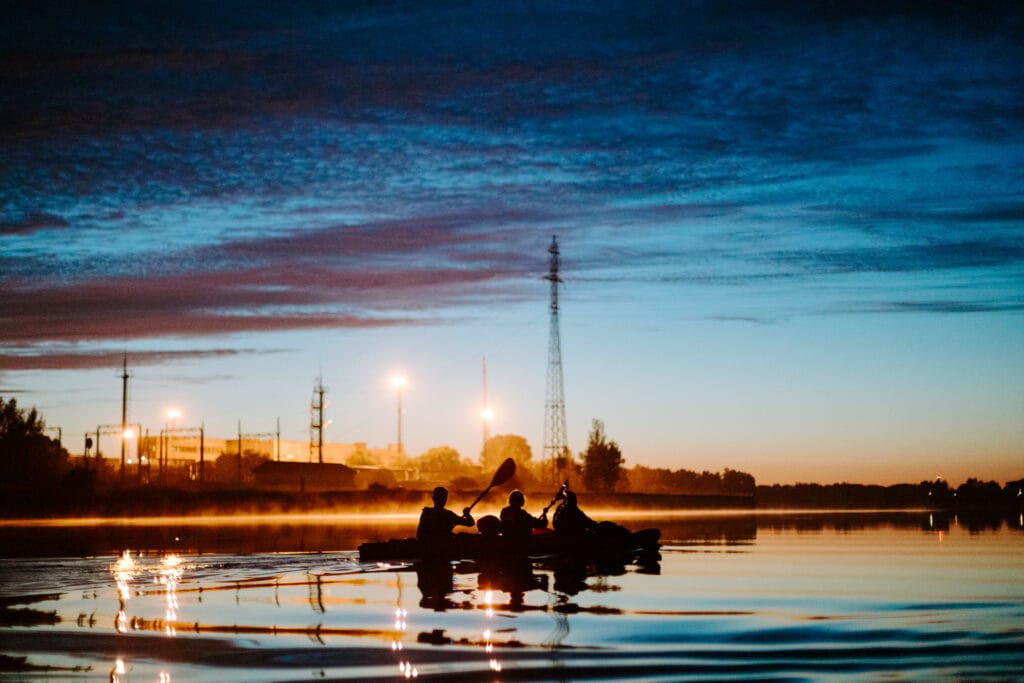
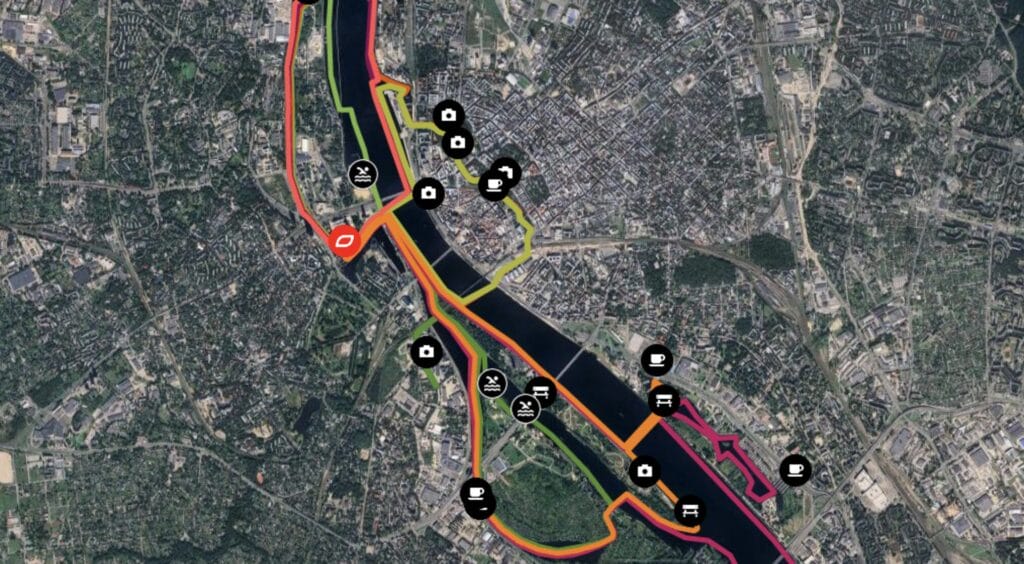
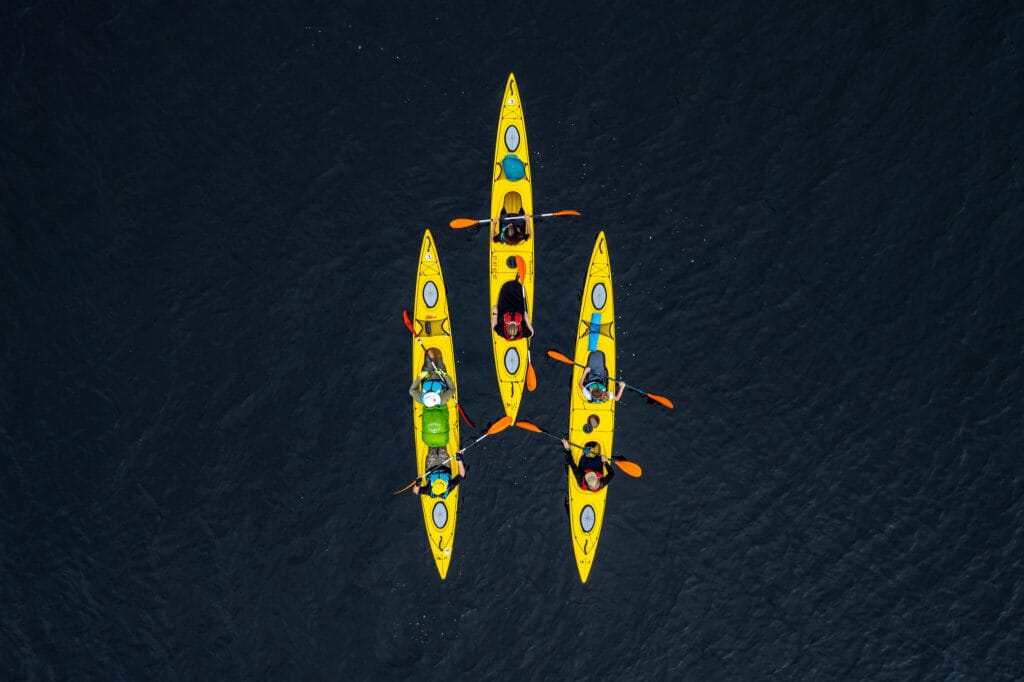
To rent a kayak: go to https://rigakayaking.com/
And if you’re looking for a quiet place to take a stroll or a nap, Marcis and Austris have put together a list of their favorite parks. You’ll find them marked on the interactive map at the end of this article.
Going out in Riga: all the best places to eat, drink and have a coffee break
I’ll be 100% honest, this section of the article we owe in its entirety to our friends! During our stay in Riga we ate very well and also discovered some nice little bars, but their list is much more local than our “random finds”.
Riga’s craft breweries and bars
As in many European capitals, the craft beer scene is booming in Riga! And we were lucky enough to taste quite a few! With our beer-loving Latvian flatmates, we regularly had deliveries of Latvian beers 😉 The best-known craft brewery, which also has its own tap-room (and tasting area in the central market), is Labietis.
To this day, these are our favorite Latvian beers, I think, and if you’re visiting the capital and enjoy craft beer, we think this is an unmissable stop 😉
A second brewery whose beers we had the opportunity to taste is Nurme. Located in the new district where our friend Aleksis’ bouldering gym is, the team behind Nurme are what we call true Beer Geeks. They obviously have a classic range, but they’re not afraid to venture into more daring blends. I have mixed feelings about their daring horseradish and sea salt beer, but their Mango Drip IPA is a real killer! In short, a brewery to indulge your taste buds!
Coffee breaks and remote working in Riga
To warm up, we always stopped for coffee and pastries in one of the small cafés belonging to the Latvian Sala chain. We found the value for money to be top-notch, and as they’re everywhere in town, they were always the first ones we came across.
But afterwards, Austris and Marcis were unanimous: they don’t offer the best coffee or the best pastries. For coffee, there are two brands that stand out from the crowd: Kalve and Rocket Bean. Both have several locations in the city (you’ll find them on our map below). By the way, Rocket Bean cafés are also great places to come and work from: they offer comfortable chairs and, above all, great wifi!
As far as bakeries are concerned, there are several that stand out in their opinion: better bread, Mikla, Bazaar and Kure (again, all these addresses can be found on the map below).
Good places to eat in Riga
During our visit to Riga we certainly ate very well, but we’ll be honest, we were poor bloggers and hadn’t taken any notes on the addresses. Fortunately, our 2 Latvian friends came to the rescue. On the map at the end of this article, you’ll find their favorite places to eat cheap in Riga. Mostly, you’ll find addresses for the best burgers, pizzas and kebabs (these guys are in their late twenties haha).
But if you want to eat Latvian, they also recommended the Lipo chain. It’s a buffet model where you help yourself to whatever you want and pay by weight. A cheap but very good 100% Latvian meal. The Ala Pagrabs pub also serves Latvian specialties in a great atmosphere (large vaulted cellars).
Discover VEF KVARTĀLS – the new arty and street food district
Another brand-new district with lots going on (especially in summer) is Vef Kartals. It’s here that Kiwie (street artist friends of Austris) have decided to set up their graphic design office. And this is not by accident! It’s a young neighborhood with plenty of concert halls, shows, bars, a bouldering gym, shared offices, exhibitions, concept stores, restaurants and street food stalls in the summer months. We haven’t been there ourselves, but there’s no doubt it’s a place we’d love to visit! To get a feel for the place, take a look at their website Instagram account.
Black Balsam
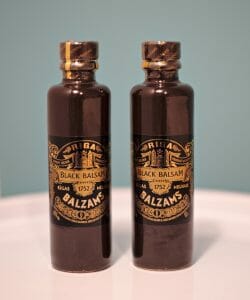
If you follow us on the blog, you know that we usually don’t say no to a drink. So we couldn’t leave Riga without having a taste of black balsam, the local alcoholic beverage. This drink was developed by a Latvian pharmacist in the middle of the 18th century and contains 20 different plants. The result is already strong enough (45%) but be aware that black balsam is typically drunk mixed with vodka (perfect to warm up during the Latvian winter) or warm with coffee or tea.
So the verdict on our side: Frankly, it’s a very, very bitter drink. Fabienne really didn’t like it and I have to say that I was grimacing at the first sip… but I think it’s the kind of drink I could like in the long run (I’m a big Suze fan if you know what i mean 😉 ).
Update 2024: there’s a blackcurrant version which is (in my opinion) less bitterly aggressive. Our Latvian friends tell us that in their eyes, this fruitier version is much more popular!
Map of all the things to do in Riga
Before we take you on a tour of the Riga area, we’d like to summarize all the addresses mentioned in this article on a single map (which will also help you choose accommodation and location according to your wishes).
- Accomodation: In Riga we rented an apartment for 9 days in the old town (as we also had to work). For 30€ / night, we had a large apartment of about 70m square in the attic with exposed beams…. just great! You’ll find lots of apartments and hotels at these prices on Booking
- If you’d like to search by location, take a look at the map below. You can enter your dates and adjust the filters (price, ratings, etc.) to refine your search.
- Getting to Riga: We came here on our road trip from Helsinki to Switzerland… in short, we came by bus!) But Riga is clearly a destination that can be easily reached on a city-trip, and cheap flights are available via Skyscanner
Getting out and about in Riga: what to see around the capital?
Day trip to Sigulda and Turaida Castle
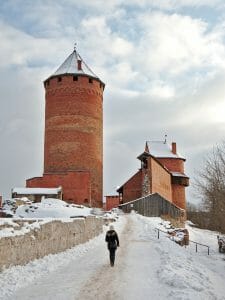
You know us, we like to go for a hike in nature as soon as we have the chance. And even if traveling in winter in the northern countries is a little more complicated, we still tried to make a small excursion to the outdoors from Riga.
The most popular destination from Riga for a day trip (even if there is enough to stay 2-3 days) is the village of Sigulda. Sigulda is a small medieval village in the Gauja National Park and is an excellent base for visiting the various castles and hiking in the park. We don’t tell you more about this place because we have a little article planned about this 😉 Edit: The article is here! 😉
And if you are looking for another idea of excursion from Riga we can only recommend that you check our article on the beautiful hill of crosses in Siauliai or take a look at the tours offered by GetyourGuide in and around Riga
To get out of Riga, it’s generally quite easy to take public transport.
If you’d like something more direct, or would prefer to be accompanied by a guide, then you’ll find plenty of tour ideas at Getyourguide or Civitatis. There are some original ideas for tours, so even if you’re not planning to take a tour with a guide, it might be an idea just to have a look around for ideas for intermediate stops.
For more independence and to combine several destinations, a great solution is to rent a car. In Riga, you can find a car for as little as €30 a day (often cheaper from the airport than from the city center). If there are 2 or more of you, it can even be cheaper than taking the bus.
To find a vehicle and compare rates between agencies, the best way is to compare on Booking (formerly known as Rentalcars)
Visit Kemeri National Park – peat bog trail
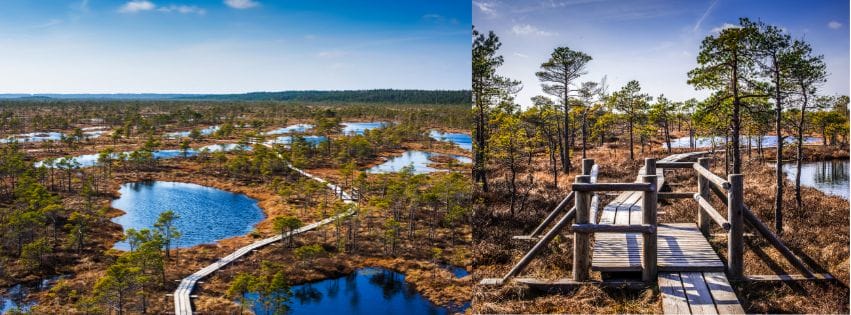
If you want to get out of the city for a while, we recommend you head for Kemeri National Park. Located 45 minutes by car (or 1h30 by public transport) to the west of Riga, this area is famous for its peat bogs and wooden walkways. There are many possible itineraries, but the best known is a 5km loop starting from the visitor center.
Tip: this itinerary is magnificent at any time of day, but the best is to go at sunrise (in summer it stings a little, but in spring or autumn it’s perfectly feasible) ;).
As mentioned above, the quickest way to get there is by car (about a 45-minute drive from the city center). Renting a car for a day costs between €30 and €50, if you compare rates on RentalCars.
The alternative is to take public transport. The easiest way is to take the train from Riga towards Tukums 2 and get off at the “Kemeri” stop. From the station, it’s a 4km walk to the official start of the trail, so remember to include those extra km in your calculations 😉 You can check the timetable on the official website. Tickets can be purchased directly at the station. The journey takes around 1 hour and the ticket costs around €3 one way (€6 return) per person.
Last option: take an organized tour. Visit Getyourguide to see tours that include a guide and the journey from the city center. These tours are charged per group (up to 4 people). In low season the price is around €90 per group, while in summer it’s around €170. If there are 4 of you and you don’t want to rent a car, this could be a good option.
Rope Jump – for adrenaline junkies
So here I am, talking to you about an activity that you have absolutely no chance of ever finding me in! 🙂 When we asked our friend Austris what he thought were the must-dos in Riga, he immediately said: “Do the rope jump! Some friends of mine do that! I’ve done dozens of jumps and it’s just the most amazing thing!”
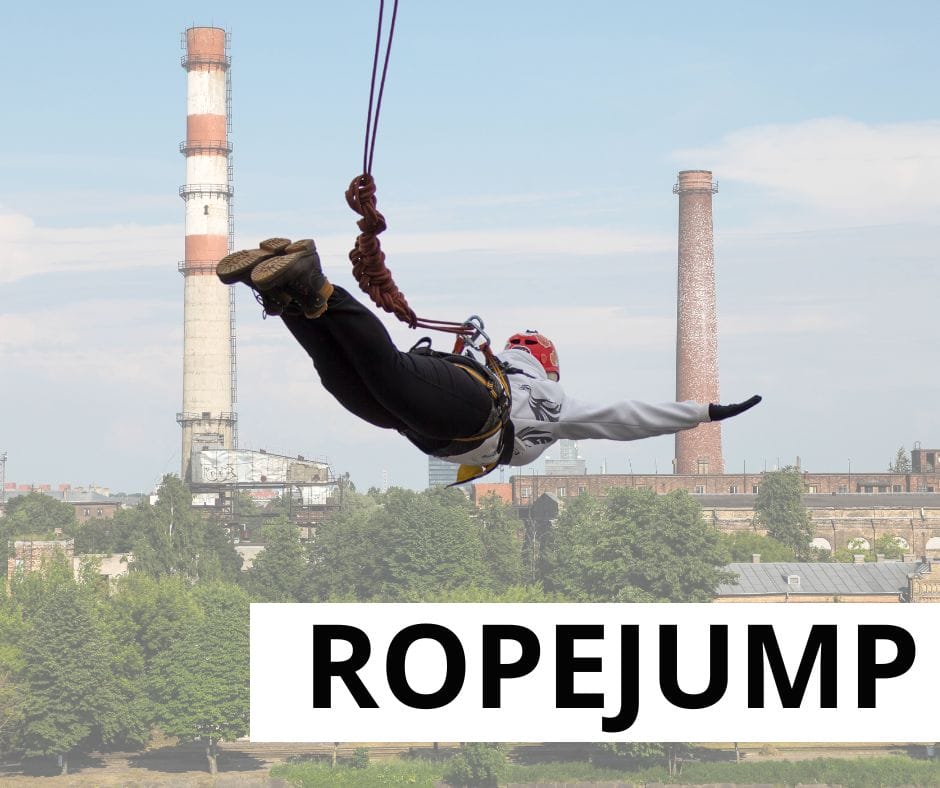
With my fear of heights and, more generally, my total aversion to activities involving adrenaline, I’ll just say that there’s no way you’ll come across me with a harness on my hips climbing up the chimney of the former Sloka paper mill 😉 But if that’s what you’re into, then we suggest you take a look at the site Ropejumping.lv.
A jump (47m of freefall) costs 80€ and a tandem jump is 150€ (assuming you want to bring your significant other or a friend along ;)). Jumps are available “à la belle saison”, i.e. from May to October. Of course, the day’s weather may lead to postponement or cancellation. See their instagram to get a better idea of what to expect
For those who are curious, this is a video of our friend’s jump –> see on instagram
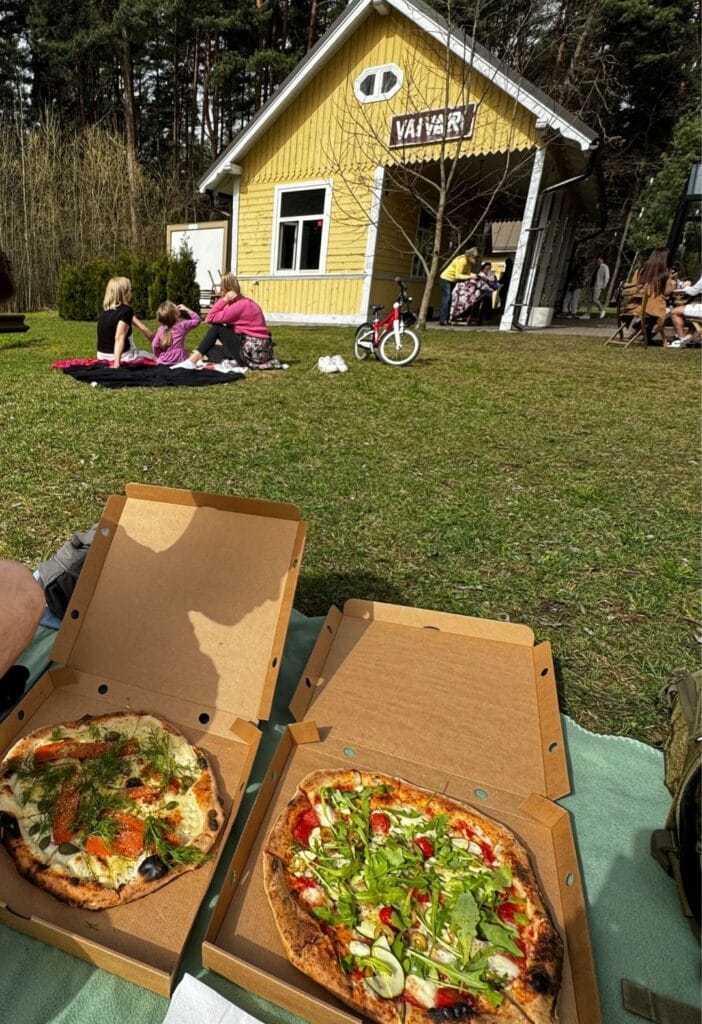
Marcis told us that not far from here are the best pizzas in the region: Stacija Vaivari Pizza (you’ll find the location on the map). The pizzeria was set up in an old abandoned railway station, and in summer you can sit on the grass next to it to enjoy your meal (or on their terrace, of course).
An original place that makes a perfect stop-off if you’re out and about in the west of the capital.
The place is also easily accessible if you decide to go to Kemeru National Park by train (just get off at Asari station and from there it’s about a 20-minute walk to the pizzeria).
Set off on an organized hike
Here again, an address 100% validated and recommended by our friend Austris. Some friends of his have set up an adventure agency specializing in small-group micro-adventures close to the city. The outings are very affordable indeed (€10 participation fee for a guided hike, public bus to the starting point at your own expense). https://letshike.co/
You can find a list of their upcoming events on their facebook page
And if you are looking for another idea of excursion from Riga we can only recommend that you check our article on the beautiful hill of crosses in Siauliai or take a look at the tours offered by GetyourGuide in and around Riga
We hope you enjoyed discovering Riga with us.
Note: This article contains so-called affiliate links to sites that we also like and use. By using our links, you pay nothing extra, but we do earn a small commission. This trip was 100% independent and all expenses were covered by us 😉 Affiliation is a way for us to monetize our site while remaining independent in our choice of destinations.
Pin it

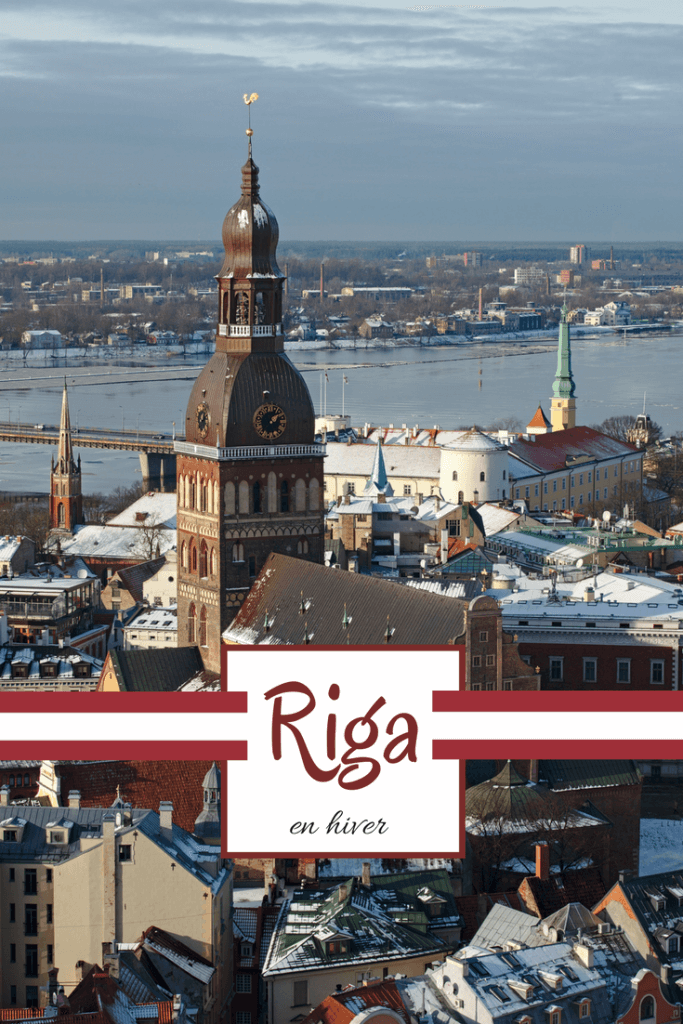
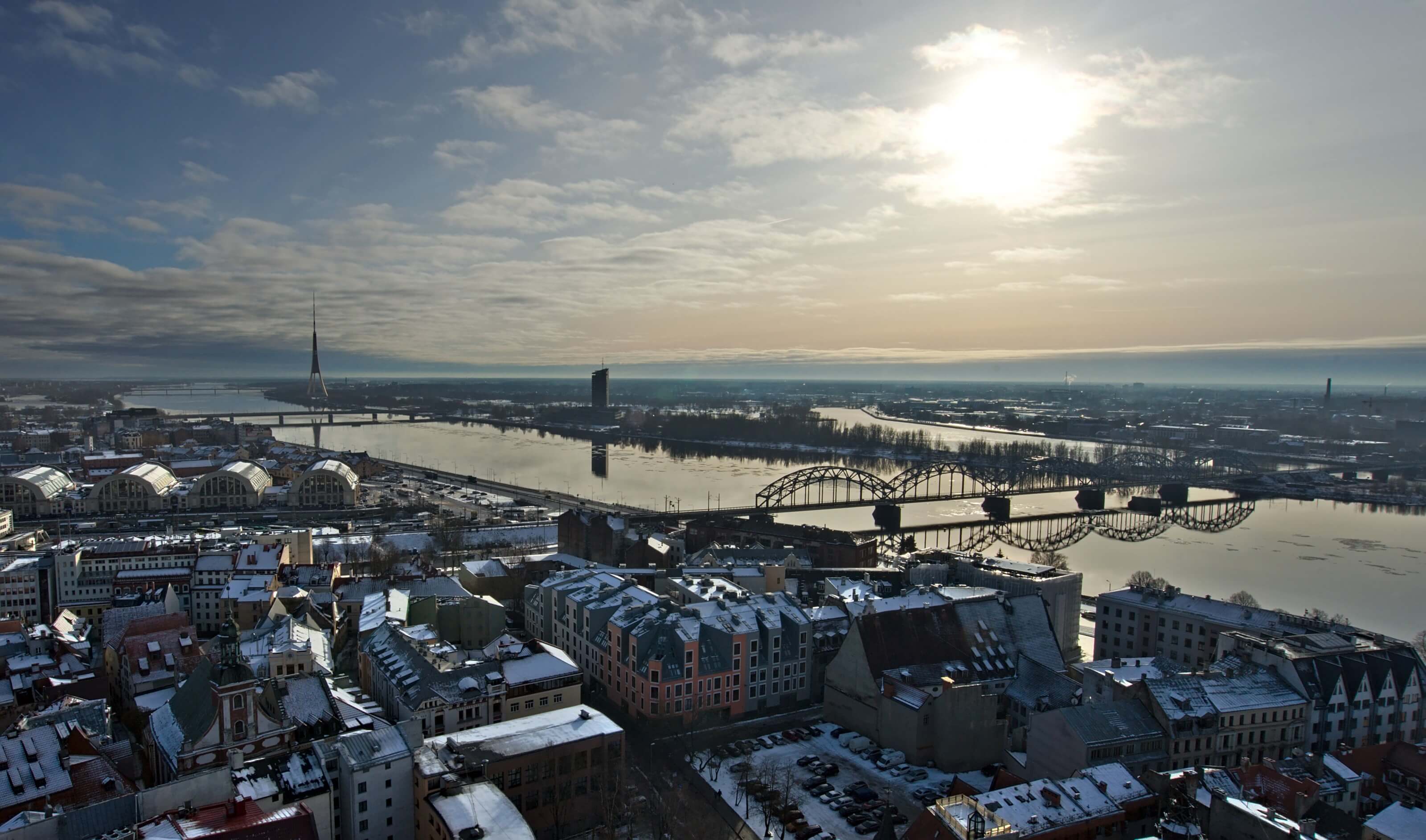
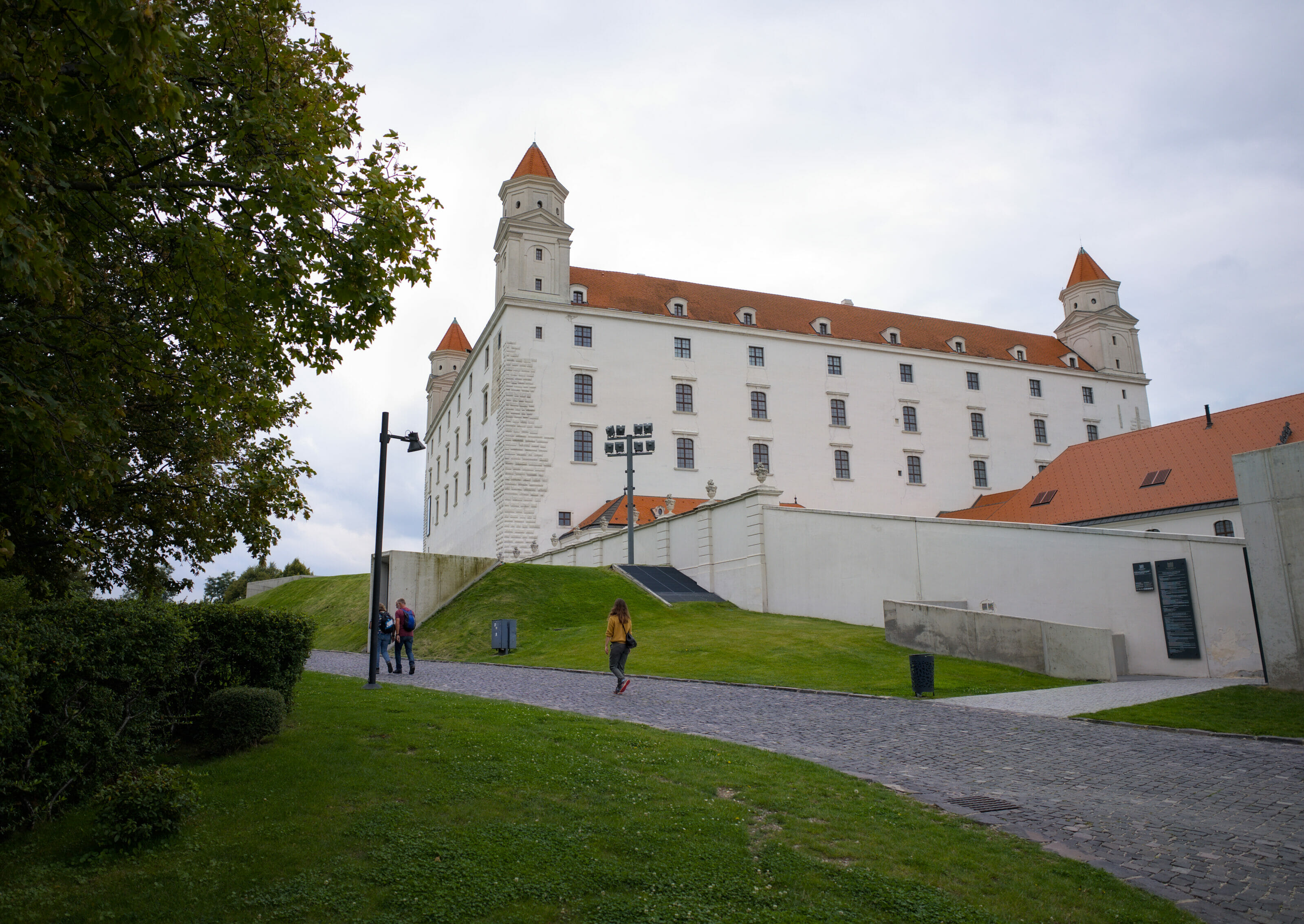
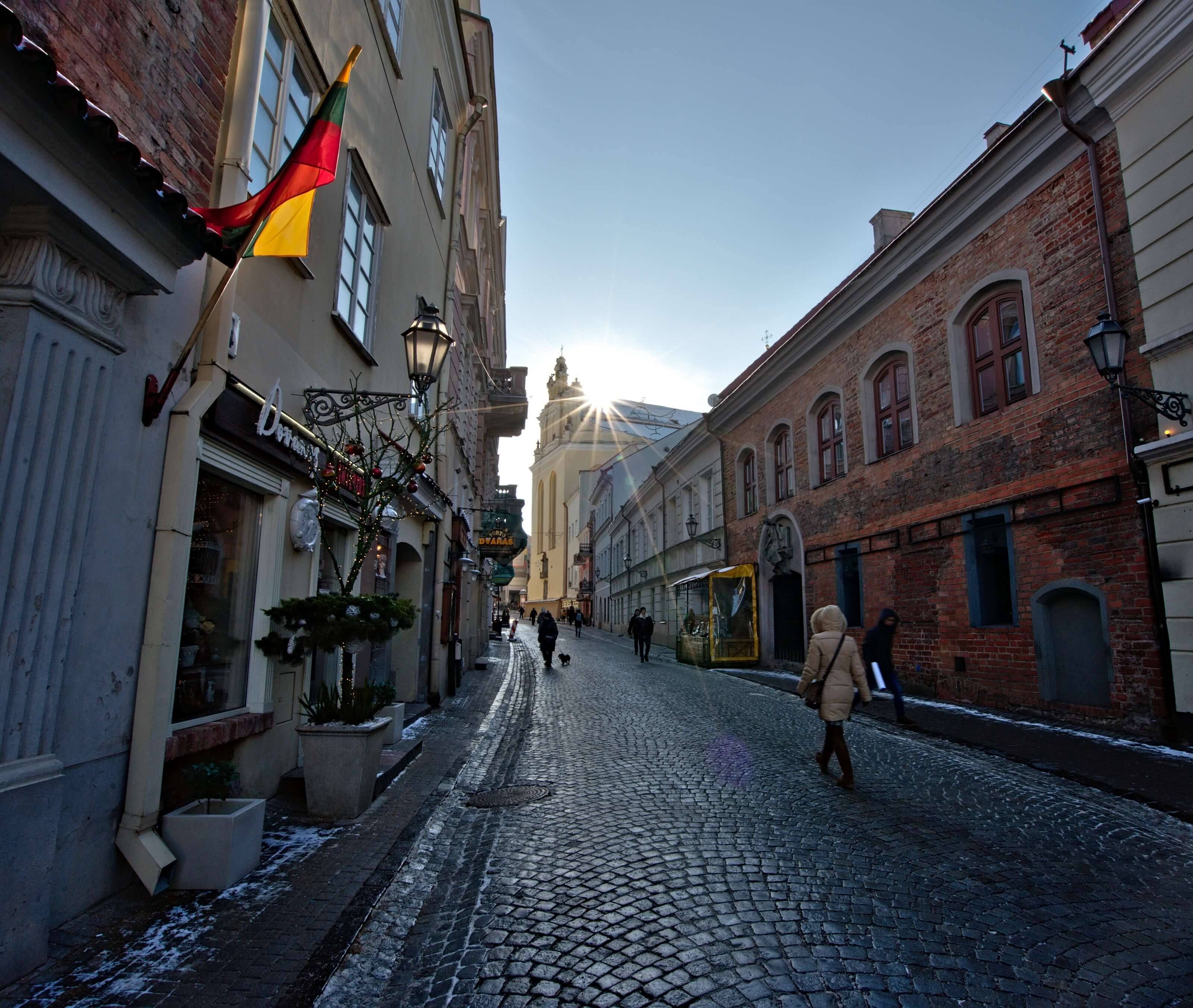
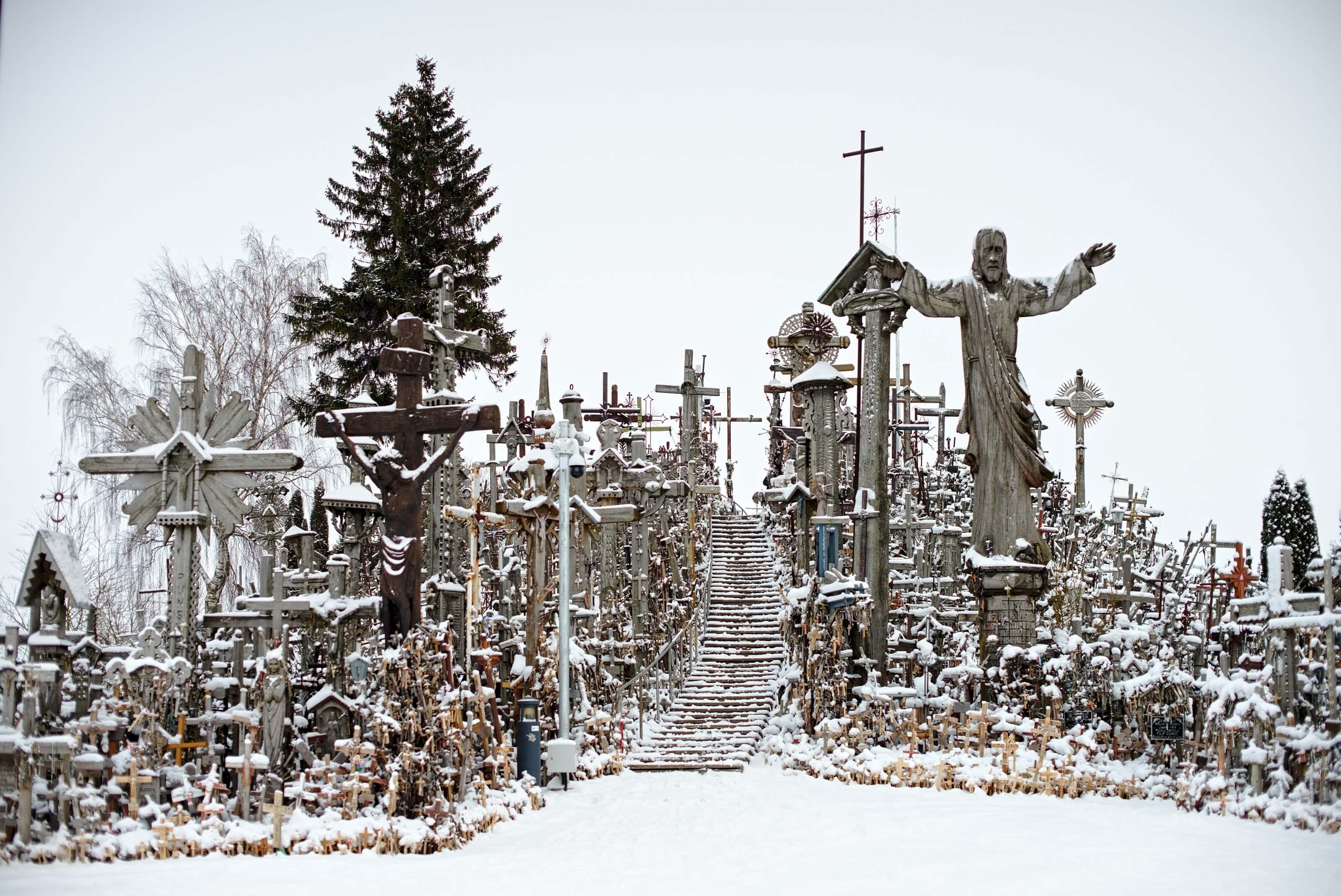
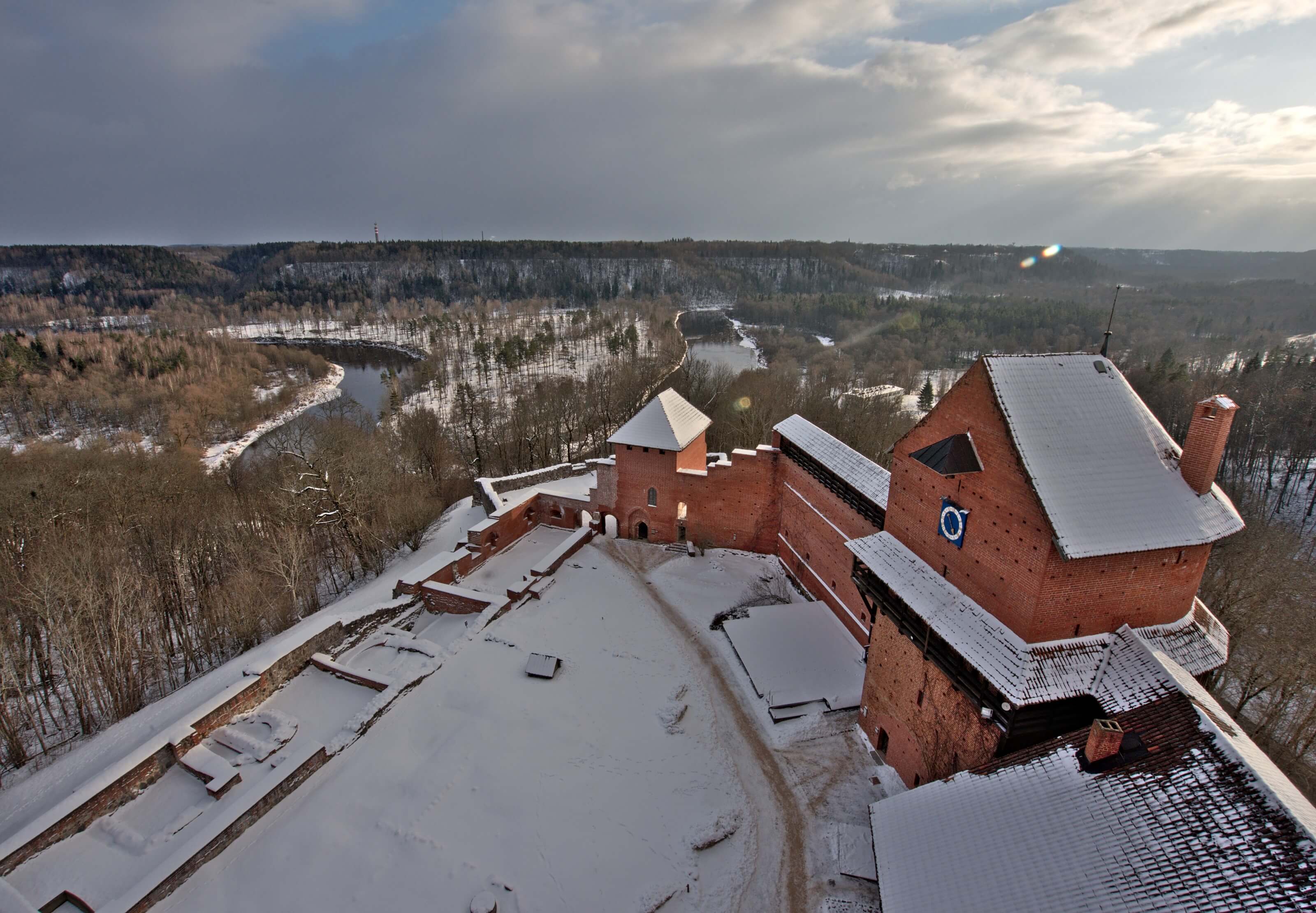
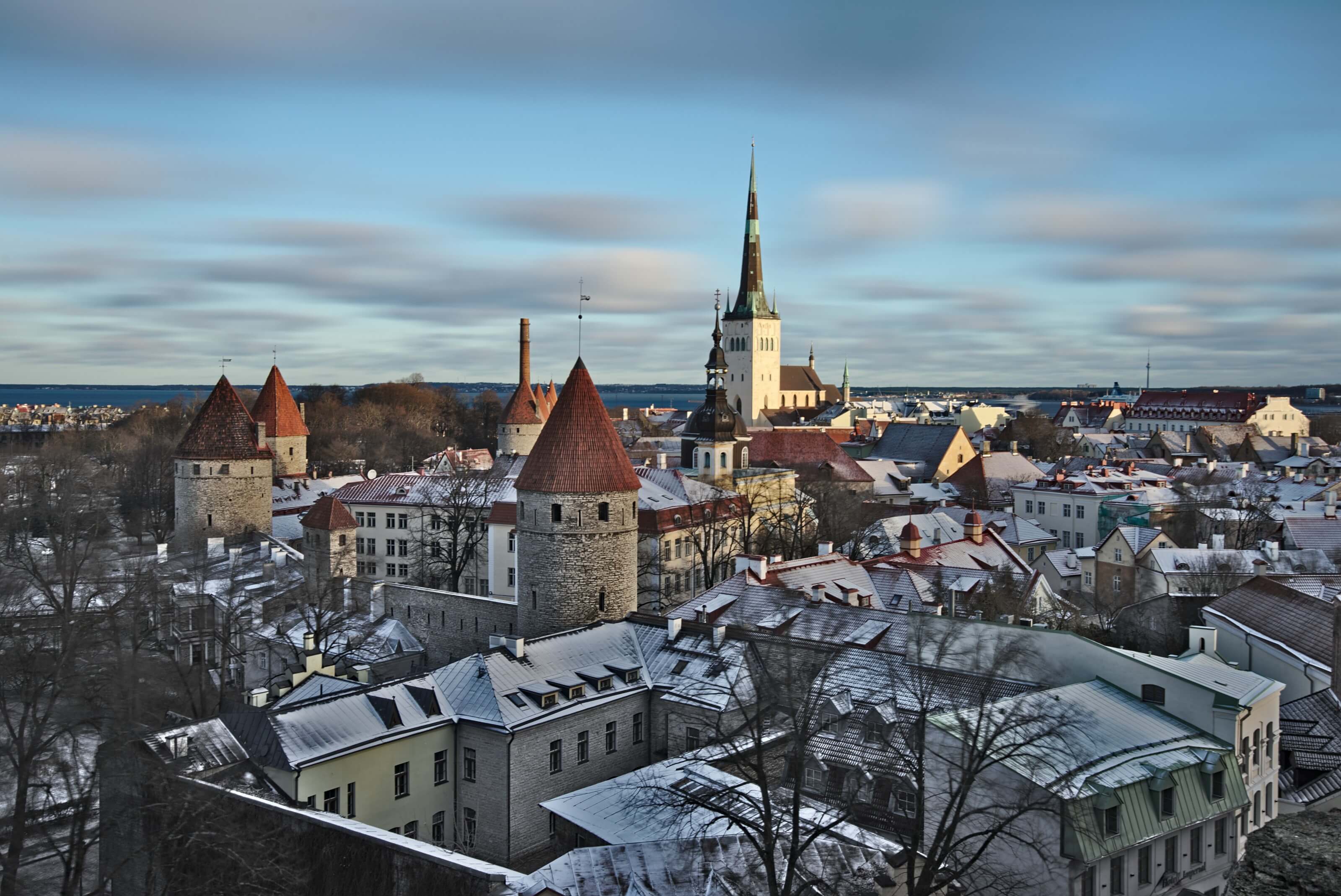
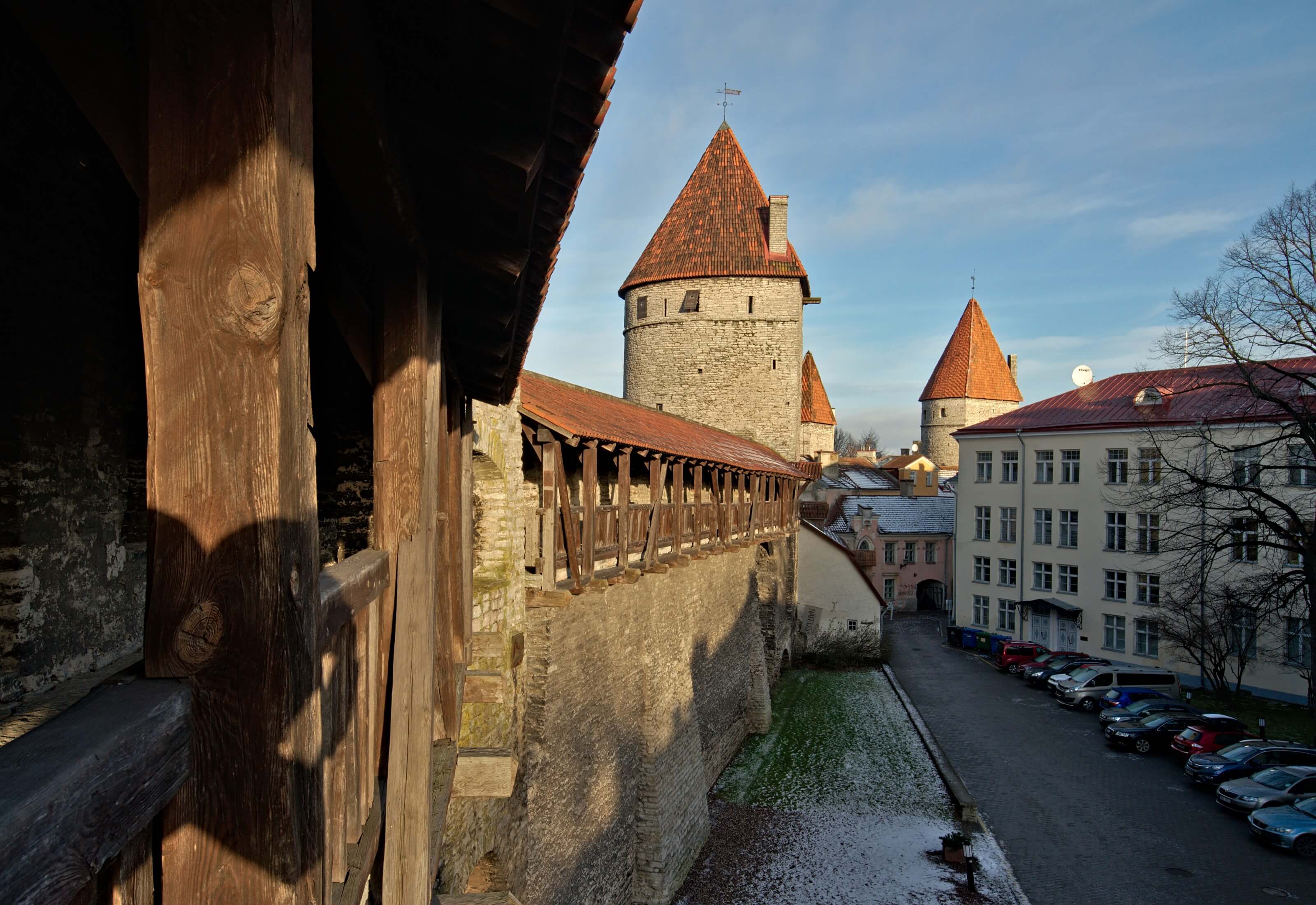
Join the discussion